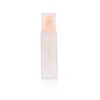What's inside
What's inside
 Key Ingredients
Key Ingredients

 Benefits
Benefits

 Concerns
Concerns

 Ingredients Side-by-side
Ingredients Side-by-side

Water
Skin ConditioningAmp-Acrylates/Allyl Methacrylate Copolymer
Polyester-5
Alcohol
AntimicrobialNiacinamide
SmoothingFerulic Acid
AntimicrobialPhenoxyethanol
PreservativeHydroxyacetophenone
AntioxidantButylene Glycol
HumectantPEG-40 Hydrogenated Castor Oil
EmulsifyingGlyceryl Stearate Citrate
EmollientSucrose Stearate
EmollientEthylhexylglycerin
Skin ConditioningPolysorbate 60
EmulsifyingParfum
MaskingHamamelis Virginiana Extract
AntiseborrhoeicGentiana Scabra Root Extract
Skin ConditioningErgothioneine
AntioxidantPanthenol
Skin ConditioningAllantoin
Skin ConditioningBisabolol
MaskingSuccinic Acid
BufferingCarica Papaya Fruit Extract
Skin Conditioning1,2-Hexanediol
Skin Conditioning3-O-Ethyl Ascorbic Acid
Skin ConditioningAscorbic Acid Polypeptide
AntioxidantMagnesium Ascorbyl Phosphate
AntioxidantSodium Ascorbyl Phosphate
AntioxidantAscorbyl Glucoside
AntioxidantMalachite Extract
AntioxidantCentella Asiatica Extract
CleansingWater, Amp-Acrylates/Allyl Methacrylate Copolymer, Polyester-5, Alcohol, Niacinamide, Ferulic Acid, Phenoxyethanol, Hydroxyacetophenone, Butylene Glycol, PEG-40 Hydrogenated Castor Oil, Glyceryl Stearate Citrate, Sucrose Stearate, Ethylhexylglycerin, Polysorbate 60, Parfum, Hamamelis Virginiana Extract, Gentiana Scabra Root Extract, Ergothioneine, Panthenol, Allantoin, Bisabolol, Succinic Acid, Carica Papaya Fruit Extract, 1,2-Hexanediol, 3-O-Ethyl Ascorbic Acid, Ascorbic Acid Polypeptide, Magnesium Ascorbyl Phosphate, Sodium Ascorbyl Phosphate, Ascorbyl Glucoside, Malachite Extract, Centella Asiatica Extract
Water
Skin ConditioningButylene Glycol
HumectantPolyester-5
Panthenol
Skin ConditioningPvp
Emulsion StabilisingPhenoxyethanol
PreservativePEG-60 Hydrogenated Castor Oil
EmulsifyingCaprylyl Glycol
EmollientOctyldodeceth-16
EmulsifyingAllantoin
Skin ConditioningEthylhexylglycerin
Skin ConditioningSodium Citrate
BufferingCitric Acid
BufferingParfum
MaskingLavandula Angustifolia Water
MaskingTocopherol
AntioxidantBenzyl Alcohol
PerfumingDehydroacetic Acid
Preservative
 Reviews
Reviews

Ingredients Explained
These ingredients are found in both products.
Ingredients higher up in an ingredient list are typically present in a larger amount.
Allantoin is a soothing ingredient known for its protective and moisturizingg properties. Because of this, it is often added to products with strong active ingredients.
Studies show higher concentrations of this ingredient can promote wound healing.
Though it can be derived from the comfrey plant, allantoin is produced synthetically for cosmetic products to ensure purity.
Learn more about AllantoinButylene Glycol (or BG) is used within cosmetic products for a few different reasons:
Overall, Butylene Glycol is a safe and well-rounded ingredient that works well with other ingredients.
Though this ingredient works well with most skin types, some people with sensitive skin may experience a reaction such as allergic rashes, closed comedones, or itchiness.
Learn more about Butylene GlycolEthylhexylglycerin (we can't pronounce this either) is commonly used as a preservative and skin softener. It is derived from glyceryl.
You might see Ethylhexylglycerin often paired with other preservatives such as phenoxyethanol. Ethylhexylglycerin has been found to increase the effectiveness of these other preservatives.
Panthenol is a common ingredient that helps hydrate and soothe the skin. It is found naturally in our skin and hair.
There are two forms of panthenol: D and L.
D-panthenol is also known as dexpanthenol. Most cosmetics use dexpanthenol or a mixture of D and L-panthenol.
Panthenol is famous due to its ability to go deeper into the skin's layers. Using this ingredient has numerous pros (and no cons):
Like hyaluronic acid, panthenol is a humectant. Humectants are able to bind and hold large amounts of water to keep skin hydrated.
This ingredient works well for wound healing. It works by increasing tissue in the wound and helps close open wounds.
Once oxidized, panthenol converts to pantothenic acid. Panthothenic acid is found in all living cells.
This ingredient is also referred to as pro-vitamin B5.
Learn more about PanthenolParfum is a catch-all term for an ingredient or more that is used to give a scent to products.
Also called "fragrance", this ingredient can be a blend of hundreds of chemicals or plant oils. This means every product with "fragrance" or "parfum" in the ingredients list is a different mixture.
For instance, Habanolide is a proprietary trade name for a specific aroma chemical. When used as a fragrance ingredient in cosmetics, most aroma chemicals fall under the broad labeling category of “FRAGRANCE” or “PARFUM” according to EU and US regulations.
The term 'parfum' or 'fragrance' is not regulated in many countries. In many cases, it is up to the brand to define this term.
For instance, many brands choose to label themselves as "fragrance-free" because they are not using synthetic fragrances. However, their products may still contain ingredients such as essential oils that are considered a fragrance by INCI standards.
One example is Calendula flower extract. Calendula is an essential oil that still imparts a scent or 'fragrance'.
Depending on the blend, the ingredients in the mixture can cause allergies and sensitivities on the skin. Some ingredients that are known EU allergens include linalool and citronellol.
Parfum can also be used to mask or cover an unpleasant scent.
The bottom line is: not all fragrances/parfum/ingredients are created equally. If you are worried about fragrances, we recommend taking a closer look at an ingredient. And of course, we always recommend speaking with a professional.
Learn more about ParfumPhenoxyethanol is a preservative that has germicide, antimicrobial, and aromatic properties. Studies show that phenoxyethanol can prevent microbial growth. By itself, it has a scent that is similar to that of a rose.
It's often used in formulations along with Caprylyl Glycol to preserve the shelf life of products.
We don't have a description for Polyester-5 yet.
Water. It's the most common cosmetic ingredient of all. You'll usually see it at the top of ingredient lists, meaning that it makes up the largest part of the product.
So why is it so popular? Water most often acts as a solvent - this means that it helps dissolve other ingredients into the formulation.
You'll also recognize water as that liquid we all need to stay alive. If you see this, drink a glass of water. Stay hydrated!
Learn more about Water